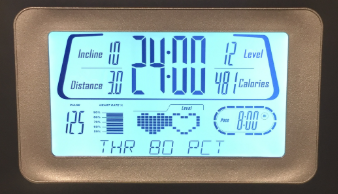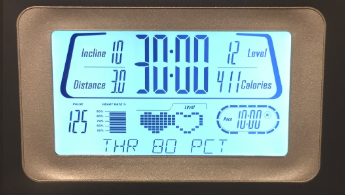11.4: Comparing Situations by Examining Ratios
- Page ID
- 39925
Lesson
Let's use ratios to compare situations.
Exercise \(\PageIndex{1}\): Treadmills
Mai and Jada each ran on a treadmill. The treadmill display shows the distance, in miles, each person ran and the amount of time it took them, in minutes and seconds.
Here is Mai’s treadmill display:


- What is the same about their workouts? What is different about their workouts?
- If each person ran at a constant speed the entire time, who was running faster? Explain your reasoning.
Exercise \(\PageIndex{2}\): Concert Tickets
Diego paid $47 for 3 tickets to a concert. Andre paid $141 for 9 tickets to a concert. Did they pay at the same rate? Explain your reasoning.
Exercise \(\PageIndex{3}\): Sparkling Orange Juice
Lin and Noah each have their own recipe for making sparkling orange juice.
- Lin mixes 3 liters of orange juice with 4 liters of soda water.
- Noah mixes 4 liters of orange juice with 5 liters of soda water.
How do the two mixtures compare in taste? Explain your reasoning.
Are you ready for more?
- How can Lin make her sparkling orange juice taste the same as Noah’s just by adding more of one ingredient? How much will she need?
- How can Noah make his sparkling orange juice taste the same as Lin’s just by adding more of one ingredient? How much will he need?
Summary
Sometimes we want to know whether two situations are described by the same rate. To do that, we can write an equivalent ratio for one or both situations so that one part of their ratios has the same value. Then we can compare the other part of the ratios.
For example, do these two paint mixtures make the same shade of orange?
- Kiran mixes 9 teaspoons of red paint with 15 teaspoons of yellow paint.
- Tyler mixes 7 teaspoons of red paint with 10 teaspoons of yellow paint.
Here is a double number line that represents Kiran's paint mixture. The ratio \(9:15\) is equivalent to the ratios \(3:5\) and \(6:10\).

For 10 teaspoons of yellow paint, Kiran would mix in 6 teaspoons of red paint. This is less red paint than Tyler mixes with 10 teaspoons of yellow paint. The ratios and are not equivalent, so these two paint mixtures would not be the same shade of orange.
When we talk about two things happening at the same rate, we mean that the ratios of the quantities in the two situations are equivalent. There is also something specific about the situation that is the same.
- If two ladybugs are moving at the same rate, then they are traveling at the same constant speed.
- If two bags of apples are selling for the same rate, then they have the same unit price.
- If we mix two kinds of juice at the same rate, then the mixtures have the same taste.
- If we mix two colors of paint at the same rate, then the mixtures have the same shade.
Glossary Entries
Definition: Double Number Line Diagram
A double number line diagram uses a pair of parallel number lines to represent equivalent ratios. The locations of the tick marks match on both number lines. The tick marks labeled 0 line up, but the other numbers are usually different.

Definition: Meters per Second
Meters per second is a unit for measuring speed. It tells how many meters an object goes in one second.
For example, a person walking 3 meters per second is going faster than another person walking 2 meters per second.
Definition: Per
The word per means “for each.” For example, if the price is $5 per ticket, that means you will pay $5 for each ticket. Buying 4 tickets would cost $20, because \(4\cdot 5=20\)
Definition: Same Rate
We use the words same rate to describe two situations that have equivalent ratios.
For example, a sink is filling with water at a rate of 2 gallons per minute. If a tub is also filling with water at a rate of 2 gallons per minute, then the sink and the tub are filling at the same rate.
Definition: Unit Price
The unit price is the cost for one item or for one unit of measure. For example, if 10 feet of chain link fencing cost $150, then the unit price is \(150\div 10\), or $15 per foot.
Practice
Exercise \(\PageIndex{4}\)
A slug travels 3 centimeters in 3 seconds. A snail travels 6 centimeters in 6 seconds. Both travel at constant speeds. Mai says, “The snail was traveling faster because it went a greater distance.” Do you agree with Mai? Explain or show your reasoning.
Exercise \(\PageIndex{5}\)
If you blend 2 scoops of chocolate ice cream with 1 cup of milk, you get a milkshake with a stronger chocolate flavor than if you blended 3 scoops of chocolate ice cream with 2 cups of milk. Explain or show why.
Exercise \(\PageIndex{6}\)
There are 2 mixtures of light purple paint.
- Mixture A is made with 5 cups of purple paint and 2 cups of white paint.
- Mixture B is made with 15 cups of purple paint and 8 cups of white paint.
Which mixture is a lighter shade of purple? Explain your reasoning.
Exercise \(\PageIndex{7}\)
Tulip bulbs are on sale at store A, at 5 for $11.00, and the regular price at store B is 6 for $13. Is each store pricing tulip bulbs at the same rate? Explain how you know.
Exercise \(\PageIndex{8}\)
A plane travels at a constant speed. It takes 6 hours to travel 3,360 miles.
- What is the plane’s speed in miles per hour?
- At this rate, how many miles can it travel in 10 hours?
(From Unit 2.3.4)
Exercise \(\PageIndex{9}\)
A pound of ground beef costs $5. At this rate, what is the cost of:
- \(3\) pounds?
- \(\frac{1}{2}\) pound?
- \(\frac{1}{4}\) pound?
- \(\frac{3}{4}\) pound?
- \(3\frac{3}{4}\) pounds?
(From Unit 2.3.3)
Exercise \(\PageIndex{10}\)
In a triple batch of a spice mix, there are 6 teaspoons of garlic powder and 15 teaspoons of salt. Answer the following questions about the mix. If you get stuck, create a double number line.
- How much garlic powder is used with 5 teaspoons of salt?
- How much salt is used with 8 teaspoons of garlic powder?
- If there are 14 teaspoons of spice mix, how much salt is in it?
- How much more salt is there than garlic powder if 6 teaspoons of garlic powder are used?
(From Unit 2.3.2)


